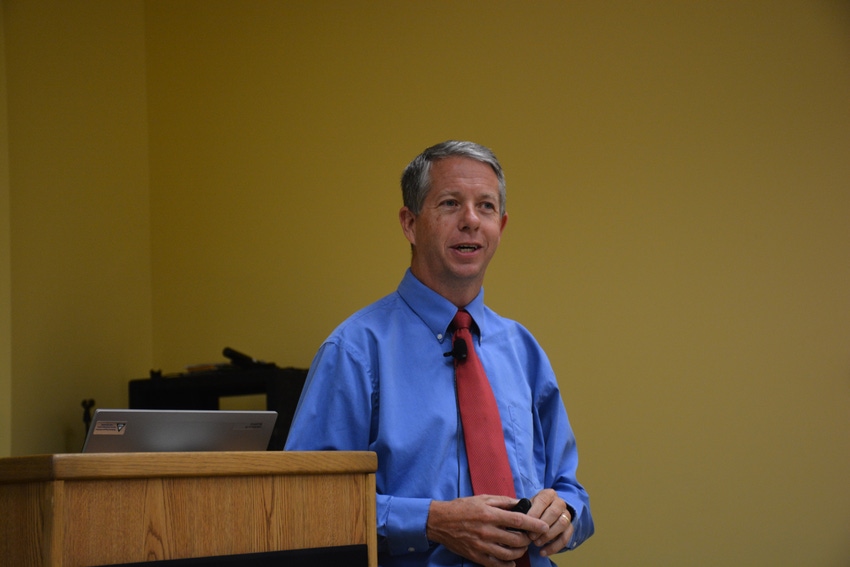
Farmers have until Feb. 27 to update their yield history and reallocate their base acreage for the 2014 farm bill and officials with USDA’s Farm Service Agency urge farmers to go by their local FSA office and complete the paperwork as soon as possible.
After a producer updates yields and reallocates base acreage, he has until March 31 to decide what program to participate in, either Agriculture Risk Coverage or Price Loss Coverage for the covered commodities.
Speaking at a farm bill educational meeting at the Livestock Arena in Rocky Mount, N.C. Oct. 28, Ron Garrett, FSA county executive director for Bertie, Gates and Northampton Counties in North Carolina said producers must make a one-time election of either ARC or PLC for the 2014 through 2018 crop years for covered commodities by the March 31 deadline.
Covered commodities are barley, canola, large and small chickpeas, corn, flaxseed, grain sorghum, lentils, mustard seed, oats, peanuts, dry peas, rapeseed, long grain rice, medium grain rice (which includes short grain rice), safflower seed, sesame, soybeans, sunflower seed and wheat. Upland cotton is no longer a covered commodity, Garrett said.
Garrett said the process of updating yield history and reallocating base acres is an important first step for receiving farm program benefits for covered commodities.
“Even if you choose a program that won’t use the new yields, it’s important that you update your yields because you never know what’s going to happen down the road in 2018 when this farm bill is over with so we encourage you to update your yields,” Garrett said.
Yield update
The last time FSA asked farmers to update their yields for farm program participation was in 2002, and before that, 1985. “So there are not many times when you have the opportunity to update your yields,” Garrett said.
“Producer certification is all it’s going to be. You just have to certify your yields. We don’t want to see your production records right now; we just want you to certify. You transfer that from your crop insurance records to the FSA form that we give you, and it is certified by farm number,” Garrett explained.
The certified yields are to come from the 2009 to 2012 crop plantings, Garrett said.
“We’re going to encourage you to do base reallocation at the same time,” Garrett added. “What does base reallocation mean? Basically it means you look at your planting history, and then you look at the bases you wish to have on your farm and you have the opportunity to keep what you already have or update on what your history has been.”
While cotton is not a covered commodity, cotton farmers who also produce covered commodities do well under the new farm program because cotton base is considered generic base under the farm bill, Garrett explained.
In fact, Garrett said understanding generic base is the most important thing for cotton farmers to comprehend for participating in the farm program.
Generic base
“Generic base is your cotton base. You just change the name ‘cotton’ to ‘generic.’ If you have 100 acres of cotton base on that farm, you now have 100 acres of generic base,” Garrett explained.
“What is different is the ability for you to plant a covered commodity on that farm for each year,” he said. “If you plant a covered commodity on that farm that generic base becomes that covered commodity for that year up to the amount of acres that you plant for the generic base.”
For example, if a farmer has 100 acres of old cotton base on a farm, that cotton acreage becomes generic base and a farmer can now plant one of the covered commodities, such as corn, and receive farm program benefits.
“Let’s say you plant 100 acres of corn on that farm, you now have 100 acres of corn base for that year. So that generic base became that corn base, but if you have already chosen to keep some corn base, you still have that corn base. That base stays with you all the way to the 2018 farm bill,” Garrett said.
For example, if a farmer chooses 50 acres of corn base in his base reallocation, that corn base stays with the farm every year of the farm bill. If a farmer also has 100 acres of generic base and plants 100 acres of corn, that generic base becomes corn base for that year.
“You have your 50 acres that stays with you for the lifetime of the farm bill, and for that year, you have that 100 acres that you planted, so you have 150 acres of corn base for that year,” Garrett explained. “That generic base becomes the covered commodity for that year.”
Garrett said this is particularly beneficial to farmers in northeastern North Carolina because each year, their generic base is going to reflect what they plant to give them support for what they plant that year.
“If I could have been put in an area just randomly as a grower with this farm bill, northeastern North Carolina is probably the best area to have been put in because you have a ton of old cotton base. We have a number of acres of old cotton base now called generic base which gives you great flexibility,” he said.
About the Author(s)
You May Also Like






